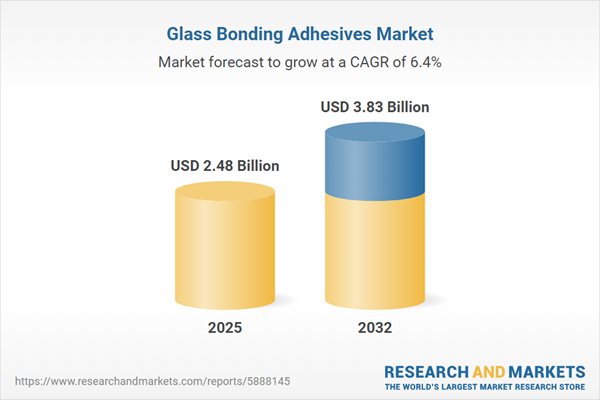Speak directly to the analyst to clarify any post sales queries you may have.
Glass bonding adhesives play an increasingly strategic role in enabling advanced design and performance standards across manufacturing, construction, and high-precision sectors. As businesses seek efficient, sustainable solutions for next-generation assembly and infrastructure, understanding the evolving glass bonding adhesives market is vital for informed decision-making.
Market Snapshot: Glass Bonding Adhesives Market
The Glass Bonding Adhesives Market grew from USD 2.33 billion in 2024 to USD 2.48 billion in 2025. It is expected to continue growing at a CAGR of 6.36%, reaching USD 3.83 billion by 2032.
Scope & Segmentation
- End Use Industries: Aerospace & Defense, Automotive, Building & Construction, Electronics, Healthcare & Medical
- Technology Types: Acrylic (Non Structural and Structural), Epoxy (One Part, Two Part), Polyurethane (One Part, Two Part), Silicone (One Part, Two Part), UV Cure
- Cure Types: Heat Cure, Room Temperature Cure, UV Cure
- Form Factors: Film, Liquid
- Sales Channels: Direct, Distributors, E Commerce
- Applications: Coating, Lamination, Sealing, Structural Bonding
- Regional Markets: Americas (United States, Canada, Mexico, Brazil, Argentina, Chile, Colombia, Peru), Europe, Middle East & Africa (United Kingdom, Germany, France, Russia, Italy, Spain, Netherlands, Sweden, Poland, Switzerland, United Arab Emirates, Saudi Arabia, Qatar, Turkey, Israel, South Africa, Nigeria, Egypt, Kenya), Asia-Pacific (China, India, Japan, Australia, South Korea, Indonesia, Thailand, Malaysia, Singapore, Taiwan)
- Leading Companies: Henkel AG & Co. KGaA, 3M Company, H.B. Fuller Company, Sika AG, Dow Inc., Arkema S.A., Ashland Global Holdings Inc., Parker-Hannifin Corporation, Huntsman Corporation, Evonik Industries AG
Key Takeaways
- Glass bonding adhesives have transitioned from niche applications to core solutions supporting demanding product requirements in various sectors.
- Major technological strides, including photoinitiated cure systems and solvent-free formulations, enable faster manufacturing while addressing sustainability priorities.
- Segment needs vary: electronics require ultra-thin, optically clear bonds, while aerospace and defense focus on mechanical strength and fatigue resistance.
- Construction, automotive, and healthcare sectors each require tailored chemistries, balancing cycle time, regulatory compliance, and durability.
- Collaboration among material suppliers, OEMs, and regulatory bodies accelerates the introduction of advanced adhesive formulations tailored to evolving market needs.
- Emerging product designs prioritize recyclability and disassembly, driving demand for innovative reversible and cleavable adhesive solutions.
Tariff Impact and Supply Chain Adaptation
Recent tariff changes in the United States have prompted industry-wide adjustments. Supply chain strategies now include greater reliance on domestic sourcing for key resin precursors and greater emphasis on nearshore partnerships. While larger manufacturers benefit from improved lead time and regional collaboration, smaller producers encounter challenges in pricing and raw material access. These shifts highlight the need for resilient procurement practices and ongoing policy monitoring to manage exposure to cost fluctuations and market access barriers.
Primary Keyword: Glass Bonding Adhesives Market
Methodology & Data Sources
The research methodology integrates direct interviews with industry experts, adhesive formulators, and OEM engineers, supported by thorough analysis of technical standards, patent filings, and regulatory documents. Qualitative insights were validated through peer-reviewed publications, regional field studies, and cross-checked with sector specialists for accuracy.
Why This Report Matters
- Supports informed decision-making by detailing segment-specific technology advances, sustainability trends, and regulatory shifts shaping buying strategies.
- Highlights competitive positioning opportunities through robust analysis of product innovations, supply chain realignment, and collaborative research frameworks.
- Helps mitigate risk by evaluating regional policy impacts and actionable procurement strategies for both established and emerging market participants.
Conclusion
This report delivers an authoritative outlook on the evolving landscape of glass bonding adhesives, offering strategic direction for business leaders seeking to optimize product development, sourcing, and market entry. With actionable insights, companies can navigate complex market dynamics and advance performance objectives in a fast-changing environment.
Additional Product Information:
- Purchase of this report includes 1 year online access with quarterly updates.
- This report can be updated on request. Please contact our Customer Experience team using the Ask a Question widget on our website.
Table of Contents
3. Executive Summary
4. Market Overview
7. Cumulative Impact of Artificial Intelligence 2025
Companies Mentioned
The companies profiled in this Glass Bonding Adhesives market report include:- Henkel AG & Co. KGaA
- 3M Company
- H.B. Fuller Company
- Sika AG
- Dow, Inc.
- Arkema S.A.
- Ashland Global Holdings Inc.
- Parker-Hannifin Corporation
- Huntsman Corporation
- Evonik Industries AG
Table Information
| Report Attribute | Details |
|---|---|
| No. of Pages | 181 |
| Published | October 2025 |
| Forecast Period | 2025 - 2032 |
| Estimated Market Value ( USD | $ 2.48 Billion |
| Forecasted Market Value ( USD | $ 3.83 Billion |
| Compound Annual Growth Rate | 6.3% |
| Regions Covered | Global |
| No. of Companies Mentioned | 11 |









